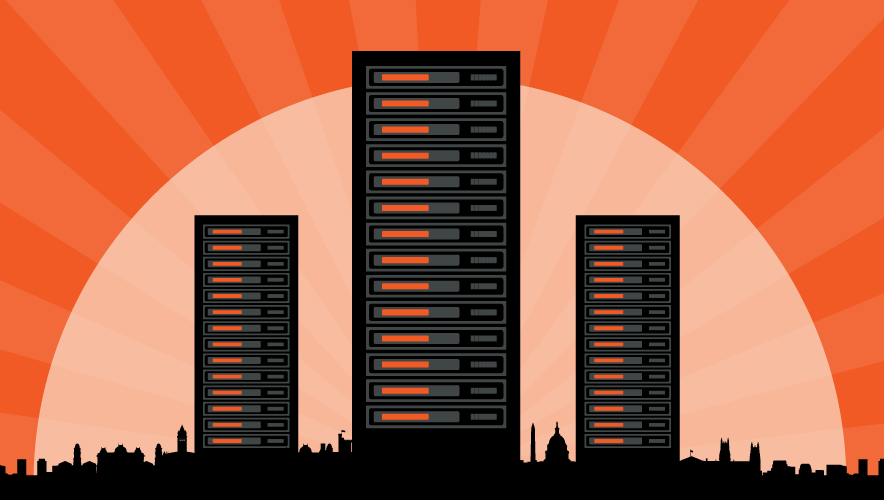A Heat Dome Hits Virginia: One Data Center's Story
What follows is a fictional account of a meteorological event, a “heat dome,” descending in the summer of 2025 on a part of the United States near the town of Ashburn, Virginia. Ashburn is home to dozens of these futuristic warehouses called data centers, each of which hosts vast arrays of computer servers in halls filled with endless racks and rows, all connected by optical fiber.
These machines hum night and day, every single day, serving the data processing and storage needs of innumerable companies and government organizations. Ashburn’s data centers require more than 2 Gigawatts of electricity to both power the computers and remove or otherwise cool the staggering amounts of heat they generate. You want your “smart” devices to work? Then you need data centers to work. You enjoy the advantages of having your mission critical applications reliably hosted in “The Cloud? The Cloud is enabled by and embodied in data centers.
Folks in the industry call Ashburn “Data Center Alley,” because it is by far the largest concentration of data centers not just in the United States, but in the world. Unlike the U.S. bulk power system, however, there are no federal or state standards for data center reliability. And extreme weather is a physical security threat to assets and operations for which gates, guards, and guns provide no defense.
Part 1/4
16 July 2025, 1200: Ops Manager Scott driving back to the Control Center after midday errand.
The Beltway was a parking lot. What was new? Scott St. Michel switched on the car radio and then clicked it off again after hearing the words “heat dome” for the hundredth time. He knew what it meant, that the jet stream had snaked into a bulbous hairpin, creating a lid of air that would continue to smother the eastern United States in extreme heat.
In Ashburn, Virginia, temperatures that had already hovered around 95 degrees Fahrenheit (35 degrees Celsius) for the last nine days were now expected to shoot up to well over 100 Fahrenheit (38 Celsius) and linger there for a week.
Scott was from Maine. He hated the heat. He wanted snow again. Ice. How long had it been since he’d felt the winter sting of a Nor’easter pelting against his skin?
His mobile buzzed. It was Emily, his wife.
“Let’s retire in Bangor,” Scott said as he answered her call. They were about 10 years off from a full stop but had already been kicking around different locations to move to, like Costa Rica or Uruguay. But who were they kidding? A former Navy intel officer, Emily loved her job in the U.S. Department of Homeland Security too much to ever retire.
“There’s a heat dome over Maine, too, you know,” Emily said.
“Feels like a heat doom.”
“Listen—we’re talking brownouts today,” Emily said.
“Where?”
Scott had seen the weather report the night before, highlighting the dome’s concentric circle of colors, from yellow at the perimeter to orange to red and then purple in the middle. As the operations manager for one of the Tier 3 X-CO data centers in Ashburn, it wasn’t the kind of news Scott wanted to see. Intermittent power outages were only going to stress his cooling systems, which had already been running hard, thanks to days of damaging record-breaking heat in the spring and early summer.
Scott surmised there was some premature wear and tear the engineering firm hadn’t factored in.
“Can’t say, yet. But better batten down the hatches, baby,” she said.
“Damn.”
“Gotta run,” she said.
“Are you home tonight?” he asked.
“Love you,” she said and hung up.
He then noticed three texts from his facilities manager, Ginger Cook. Normally she was graceful under pressure, a cool cucumber type. She didn’t sound too cool at the moment, though.
“What’s your ETA?
“Back yet?”
There was a break in the traffic, and Scott sped up for the exit.
Headquartered in Dulles, Virginia, X-CO was one of the leading data center companies in the world with hundreds of centers across the United States, including some gigantic facilities—hyperscalers—in Ashburn and Manassas. Founded in 2008, X-CO had grown through a series of acquisitions and in 2024 its fleet ranged from the very latest designs to some that were beginning to show their age. Last year’s heat knocked a few of the older units offline for a while, but Scott made it through without a blip.
He wound his way along the access road’s sharp twists and turns, through the gates, past the concrete barricades and other physical security elements guarding this fortress of a facility towards the parking lot.
In the last minute of his drive, he started to sweat and cranked his car’s AC to the max. But instead of a cool blast, the air came out like a tropical breeze. What a fine time to quit. He got out, closed the door, and made his way to the data center’s entrance.
Ginger texted again: “Meet me at the chillers ASAP.”
Part 2/4
1230: Scott gets a rapid update from one of his senior techies.
After clearing the security checkpoint, Scott set off on a jog down the east hallway, half a football-field’s length of corridor whose only job was to connect the server halls with the control room. The building was a vessel, and there were times he felt a whiff of nostalgia for his submarine days. Some of the systems he worked on then were comparable to these and prepared him well for this duty. And the stakes back then—the loss of navigation, situational awareness, communications—were a matter of life and death for him and his fellow crewmates, not to mention a possible mission failure that would let the nation down.
The stakes, albeit different, were just as high and potentially more impactful considering how many high-profile global businesses’ and U.S. government agencies’ data his systems processed and stored. X-CO’s customers, almost too many to count, had service level agreements service level agreements (SLAs) guaranteeing them extremely low latencies and virtually uninterrupted service every single day of the year. The amount of money in play was astronomical.
Ginger was pacing in front of the door to the chillers. “Hear that?” she asked while handing him a pair of ear guards.
“Sounds like an animal in pain.”
“Or bearings grinding down. Maybe blown gaskets.”
They put their ear guards on and went inside.
Ginger led Scott to the source. The chiller units in front of them were working harder than he’d ever heard them before, but with the outside ambient air temperature way above its compressor’s application envelope for more than week, the stress was starting to show.
Scott knew the American Society of Heating, Refrigerating and Air-Conditioning Engineers’ guidance on this. The authoritative standards body for high performance heating and cooling systems, ASHRAE told engineer-designers that the highest temperature they would ever see in a 20-year period in nearby Dulles would be 103 degrees Fahrenheit (39 degrees Celsius) with 0 percent humidity. But today it was indeed that hot but with 70 percent humidity, so the wet bulb temperature was 93.9 degrees Fahrenheit. ASHRAE said all was well as long as the wet bulb temperature remained below 83.4 degrees. Hence, all was not nearly well. The chiller units simply couldn’t work in these conditions, this hard, for this long.
He had worried about this exact problem during a heat wave last year; even senior management said they needed to upgrade or retrofit their chillers for extreme weather beyond what the standards called for. But no one else was doing that, so his proposal to enhance their facility was turned down. Management seemed more focused on building shiny new facilities than preparing existing ones for conditions that were clearly changing.
Back out in the hall, Scott asked Ginger to call maintenance and then get in touch with Rico Hansen at X-CO in Manassas, a similarly designed, similarly aged sister site, to see how its chillers were doing.
“Roger that.” She scurried off ahead and was soon out of sight.
Despite having confidence in his backup power systems, Scott wondered if the impending brownouts Emily mentioned would put additional stress on his facility. Maybe the utility would spare his data center in the case of a selective brown out. If the grid started to blink out or worse, blackout, for a day or more, then backup systems may not be up to the task—even if they had enough diesel. And if there was a prolonged blackout, Scott really hoped his plant was near the top of the queue for restoration.
Part 3/4
1315: Ginger catches up with Scott in his office.
Ginger opened the door to Scott’s office, where he was staring at the situational awareness dashboard screens in disbelief.
“Rico said they’re no better off than we are … maybe worse,” she said. “They’re not going to make it and I don’t think we will either. He said he’s heard cooling is failing at Tier 2, 3, and even 3+ certified centers. This heat dome thing is showing no signs of stopping. If we don’t initiate server hall power down soon, things could get even uglier.
“What do you mean, specifically?” Scott asked.
“Chillers, compressors, condensers, the air handlers, even the uninterruptible power systems (UPSs), are in or approaching red. You’ve seen it yourself if you’ve seen the dashboard, heard the alarms.
“We’ve migrated as much load offsite as we could in the previous days, but we’re going to fry somewhere between half and all our servers if we don’t begin powering them down in the next 60 minutes. I’m not even sure there’s that much time.”
Under his breath, Scott muttered “Damn it.”
Ginger concluded. “Our choice is to protect the equipment, so it’ll be ready when this nightmare weather passes.” Always the voice of reason, which is why she was so great at her job.
“Or run it into the ground in the name of the holy SLAs,” Scott said.
Ginger watched him, unblinking. “Time to call the big guy.”
Part 4/4
1330: Scott calls the X-CO Chief Operating Officer
Scott’s previous encounters with his boss Jim Wagner had been positive. Unlike other senior executives, Jim seemed to have the right mix of relevant engineering experience, some of it gained during his early Navy days, and a balanced temperament. And not only that, he was a genuine people person, comfortable in his own skin and adept at making his subordinates feel comfortable in theirs too—even when talking through performance issues.
Despite all that, the call today was going to be a monster. And one thing Scott didn’t know was that his was not the first call of its kind this day.
“Jim, I’m sorry to have to tell you this but we’re going to have cease operations, at least until this heat dome thing ...” Scott said before he was interrupted.
“Absolutely not,” Jim said, abrupt and pointed. “That’s not an option. Several of your peers have already thrown in the towel today and failovers are not working. I need you to engineer your way out of this, cause otherwise we’re screwed. How about you dust off the battle short policies and get the Fire Department to tanker some Potomac water here pronto.”
Scott knew Jim had remote access to the same dashboards he had in his own control center. He told him their cooling systems were FUBAR and that they’re about to shut down, adding “If we don’t power down now, all the servers in our halls will fry and we won’t be able to stand back up when the heat finally passes.”
Jim went quiet for a minute. To Scott, it felt like an eternity, but he wondered if Jim might relent. Jim then released a string of obscenities, saying, “Whatever you do, don’t pull the plug Scott, I’m warning you.” He ended the call.
Scott, shaken, took several deep breaths, and then got his head crewperson on the line. He knew what he had to do.
“Time to initiate shutdown.”
Scene 1 END
This is part one of a three-part series that Security Technology will publish during December 2022, illustrating the ramifications of a heat dome settling on Data Center Alley in Ashburn, Virginia.
Andy Bochman is a senior grid strategist and defender at the Idaho National Lab, where he provides strategic guidance on topics at the intersection of grid security and climate resilience to senior U.S. and international government and industry leaders. He is also a non-resident senior fellow at the Atlantic Council’s Global Energy Center.
Special thanks to editors and SME fact checkers: Sunny Wescott, Megan Gates, Tracy Staedter, Gary Cudmore, Eric Whiting, Lisa Martine Jenkins, and Tim Roxey.
© 2022 Andy Bochman














